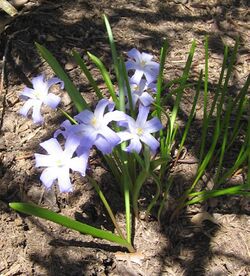Biology:Chionodoxa luciliae
| Chionodoxa luciliae | |
|---|---|

| |
| Scientific classification Error creating thumbnail: Unable to save thumbnail to destination
| |
| Kingdom: | Plantae |
| Clade: | Tracheophytes |
| Clade: | Angiosperms |
| Clade: | Monocots |
| Order: | Asparagales |
| Family: | Asparagaceae |
| Subfamily: | Scilloideae |
| Genus: | Chionodoxa |
| Species: | C. luciliae
|
| Binomial name | |
| Chionodoxa luciliae Boiss.
| |
| Synonyms | |
| |
Chionodoxa luciliae (syn. C. gigantea), the Bossier's glory-of-the-snow[1] or Lucile's glory-of-the-snow, is a bulbous perennial from west Turkey flowering in early spring. After flowering, it goes into dormancy until the next spring. The Latin name is in honour of Lucile, the wife of the Swiss botanist Pierre Edmond Boissier.[2]
Like all members of the genus Chionodoxa, the bases of the stamens are flattened and closely clustered in the middle of the flower. In the related genus Scilla, the stamens are not flattened or clustered together.[3] The differences are not considered by some botanists as sufficient to create a separate genus, so they include this species in Scilla.[4]
Each bulb produces two leaves, up to 8 cm long and 2 cm wide, and at most one flowering stem, up to 10 cm long. The flowers are produced in a loose pyramidal raceme, with 2–3 flowers per stem, which face upwards. Each flower is up to 3.5 cm across. The base of each tepal is white (as are the stamen filaments), producing a white 'eye'. The outer part of the tepals is violet-blue. The species can be distinguished from the commonest form grown in gardens, C. siehei, by the much smaller number of slightly larger flowers per stem.[5]
Under its synonym Scilla luciliae this plant has gained the Royal Horticultural Society's Award of Garden Merit.[6] (confirmed 2017).[7]
Notes and references
- ↑ "BSBI List 2007" (xls). Botanical Society of Britain and Ireland. http://www.bsbi.org.uk/BSBIList2007.xls. Retrieved 2014-10-17.
- ↑ "Paghat's garden". Paghat.com. http://www.paghat.com/chionodoxa.html. Retrieved 2018-10-08.
- ↑ Mathew 1987, p. 25
- ↑ Dashwood & Mathew 2005, p. 5
- ↑ Dashwood & Mathew 2005, p. 7
- ↑ "RHS Plantfinder - Scilla luciliae (Boiss.) Speta". https://www.rhs.org.uk/Plants/370277/i-Scilla-luciliae-i-(Boiss-)-Speta/Details. Retrieved 10 July 2018.
- ↑ "AGM Plants - Ornamental". Royal Horticultural Society. July 2017. p. 16. https://www.rhs.org.uk/plants/pdfs/agm-lists/agm-ornamentals.pdf. Retrieved 24 January 2018.
Bibliography
- Dashwood, Melanie & Mathew, Brian (2005), Hyacinthaceae – little blue bulbs (RHS Plant Trials and Awards, Bulletin Number 11), Royal Horticultural Society, archived from the original on 28 August 2015, https://web.archive.org/web/20150828121015/https://www.rhs.org.uk/Plants/PDFs/Plant-trials-and-awards/Plant-bulletins/hyacinthaceae, retrieved 28 August 2015* Mathew, Brian (1987), The Smaller Bulbs, London: B T Batsford, ISBN 978-0-7134-4922-8
- Mathew, Brian (2005), "Hardy Hyacinthaceae, Part 2: Scilla, Chionodoxa, xChionoscilla", The Plantsman (New Series) 4 (2): 110–21
Wikidata ☰ Q970846 entry

